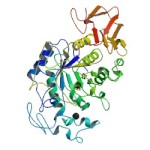In this week’s reading, I learned that enzymes are the most common and efficient catalysts found in nature and that most reactions (whether in the body or life in general), would occur very slowly, if at all, without catalysts. Enzymes are biological catalysts that increase the rate of chemical reactions. Most enzymes are proteins and their catalytic action is a result of their complex structure. The diversity of the protein structure allows different enzymes to produce specialized reactions.
My “Catalyst of the Week” is a digestive enzyme, largely because I plan to specialize in digestion in my Chinese medicine studies. It is Amylase.
Amylase is an enzyme that breaks starch down into sugar. Amylase is present in human saliva, where it begins the chemical process of digestion. Foods that contain much starch but little sugar, such as rice and potato, taste slightly sweet as they are chewed because amylase turns some of their starch into sugar in the mouth. The pancreas also makes amylase (alpha amylase) to break down dietary starch into di- and trisaccharides which are converted by other enzymes to glucose to supply the body with energy.
If there are abnormal concentrations of amylase, that is pathognomonic (a term I learned in medical terminology to mean characteristic of a specific desease) of Pancreatitis or a perforated peptic ulcer.
Plants and some bacteria also produce amylase. As diastase, amylase was the first enzyme to be discovered and isolated (by Anselme Payen in 1833). Specific amylase proteins are designated by different Greek letters. All amylases are glycoside hydrolases and act on α-1,4-glycosidic bonds. (I read that on Wikipedia but an not sure what that means.)
Here’s A diagram of an amylase molecule from human saliva. The calcium ion is visible in pale khaki; and the chloride ion in green.